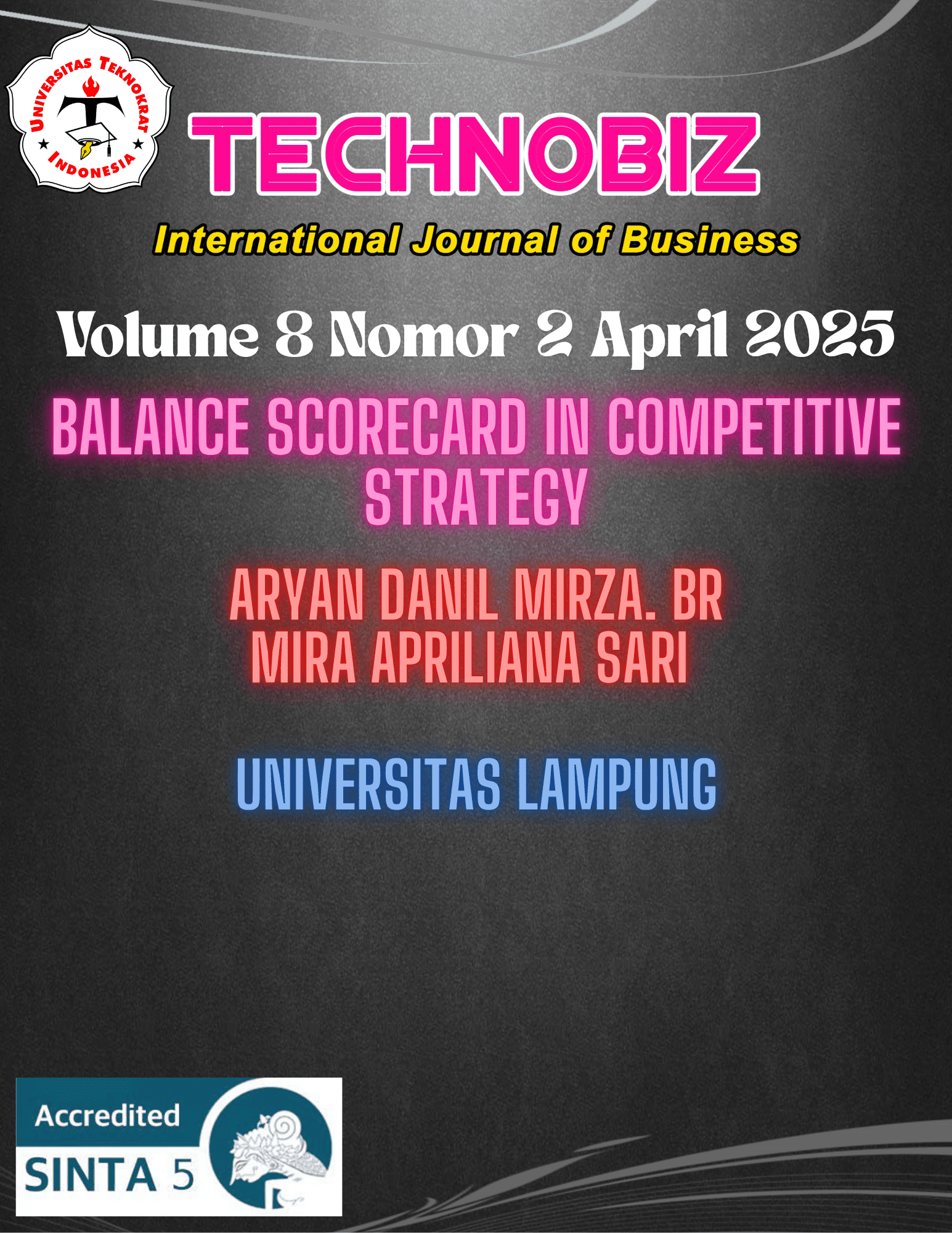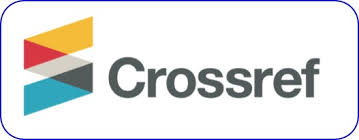BALANCE SCORECARD IN COMPETITIVE STRATEGY
Abstract
The purpose of this study is to explain how the implementation of the Balanced Scorecard can be used to improve business strategy, especially in companies implementing competitive strategies. The world of business and government have both adopted the BSC as a tool for measuring performance, but its implementation is not without challenges. One of these challenges is determining which perspective to highlight when building the relationship between performance and strategy. This study is qualitative and takes a literature-based approach. This study shows that competitive strategies take a slightly different approach by using the BSC model, and this is reflected in strategy formulation.
References
Abraham, S. C. (Ed.). (2012). Strategic planning: A practical guide for competitive success. Emerald Group Publishing.
Agostino, D., & Arnaboldi, M. (2011). How the BSC implementation process shapes its outcome. International Journal of Productivity and Performance Management, 60(2), 99-114.
Alewine, H. C., & Miller, T. C. (2016). How balanced scorecard format and reputation related to environmental objectives influence performance evaluations. In Advances in management accounting (pp. 123-165). Emerald Group Publishing Limited.
Anand, M., Sahay, B. S., & Saha, S. (2005). Balanced scorecard in Indian companies. Vikalpa, 30(2), 11–25. https://doi.org/10.1177/0256090920050202.
Arslan, I. K. (2020). The importance of creating customer loyalty in achieving sustainable competitive advantage. Eurasian Journal of Business and Management, 8(1), 11-20.
Balodi, K. C. (2014). Strategic orientation and organizational forms: an integrative framework. European Business Review, 26(2), 188-203.
BR, A. D. M., & Mareta, F. (2023). Does Performance Evaluation Mattered? An Explanation from Literature Study. Journal of Applied Accounting and Taxation, 8(2), 40-46.
Chavan, M. (2009). The balanced scorecard: a new challenge. Journal of management development, 28(5), 393-406.
Ciptani, M. K. (2004). Balanced Scorecard Sebagai Pengukuran Kinerja Masa Depan: Suatu Pengantar. Jurnal Akuntansi Dan Keuangan, 2, 21–35.
Daly, D. 1996. Performance Measurement and Management. Management Accounting 78/3 (September): 65-66.
Ebert, C., Bundschuh, M., Dumke, R., & Schmietendorf, A. (2005). Making metrics a success—the business perspective. Best Practices in Software Measurement: How to use metrics to improve project and process performance, 9-34.
Fan, X., & Zhang, S. (2016). Performance evaluation for the sustainable supply chain management. sustainable supply chain management, 141-194.
Galbreath, J., Lucianetti, L., Tisch, D., & Thomas, B. (2022). Firm strategy and CSR: The moderating role of performance management systems. Journal of management & organization, 28(1), 202-220.
Kaplan, R.S., and D.P. Norton. 1992. The balanced scorecard—Measures that drive performance. Harvard Business Review 70/1(January-February): 71-79.
Kaplan, R. S. (2009). Conceptual Foundations of The Balanced Scorecard. Handbooks of Management Accounting Research, 3, 1253-1269.
Khalid, S., Beattie, C., Sands, J., & Hampson, V. (2019). Incorporating the environmental dimension into the balanced scorecard: A case study in health care. Meditari Accountancy Research, 27(4), 652-674.
Khomba, J. K. (2015). Conceptualisation of the Balanced Scorecard (BSC) model: A critical review on its validity in Africa. International Journal of Commerce and Management, 25(4), 424-441.
Lajo, A. (2023). The Relationship between Strategic Targets and Measurement: Structuring a Calibration Model of Planning, Measuring, and Implementing Performance Considering Non-financial Factors.
Lee, C. L., & Wang, W. Y. (2020). Strategy, accountants’ activities and new product development performance. Advances in accounting, 50, 100487.
Leppänen, P., George, G., & Alexy, O. (2023). When do novel business models lead to high performance? A configurational approach to value drivers, competitive strategy, and firm environment. Academy of management journal, 66(1), 164-194.
Liu, W., & Atuahene-Gima, K. (2018). Enhancing product innovation performance in a dysfunctional competitive environment: The roles of competitive strategies and market-based assets. Industrial Marketing Management, 73, 7-20.
Lucianetti, L., Battista, V., & Koufteros, X. (2019). Comprehensive performance measurement systems design and organizational effectiveness. International Journal of Operations & Production Management, 39(2), 326-356.
Mantra, Bagoes.(2008). Demografi Umum. Yogyakarta: Pustaka Pelajar.
Mattson, Beth, (1999). Executives learn how to keep score: Balanced Scorecard gets all employees focusing on vision, http://www.ianalliot.com.
Maury, B. (2022). Strategic CSR and firm performance: The role of prospector and growth strategies. Journal of Economics and Business, 118, 106031.
Mavrinac, Sarah, dan Michael, Vitale, (1999). The Balanced Scorecard, http://www.research.com.
Mowen, Maryanne M., Hansen Don R., dan Heitger, Dan L. 2019. Dasar-Dasar Akuntansi Manajerial. Jakarta: Salemba Empat.
Murni, T. (2017). The Effect of Entrepreneurial Orientation to Low-Cost Strategy, Differentiation Strategy, Sustainable Innovation and Performance of Small and Medium Enterprises (Studies at Batik Small and Medium Enterprises in East Java Province, Indonesia). European Journal of Business and Management, 9(20), 137-53.
Nair, M. (2004). Essentials of Balanced Scorecard. John Wiley & Sons.
Narayanamma, P. L., Babu, D. S., & Jayasankaraprasad, C. (2016). Balanced Scorecard and Its Iterations. IOSR Journal of Business and Management, 18(12), 78–82. https://doi.org/10.9790/487X-1812027882
Nugrahayu. (2015). Penerapan Metode Balanced Scorecard Sebagai Tolok Ukur Pengukuran Kinerja Perusahaan. Jurnal Ilmu & Riset Akuntansi, 4(10), 1–16.
Olson, E., & Slater, S. F. (2002). The balanced scorecard, competitive strategy, and performance BH075 Business Horizons. Business Horizons, 075(800).
Otley, D. (1999). Performance management: a framework for management control systems research. Management accounting research, 10(4), 363-382.
Oyewobi, L. O., Windapo, A. O., & Rotimi, J. O. B. (2015). Measuring strategic performance in construction companies: a proposed integrated model. Journal of Facilities Management, 13(2), 109-132.
Pimentel, L., & Major, M. J. (2014). Quality management and a balanced scorecard as supporting frameworks for a new management model and organisational change. Total Quality Management & Business Excellence, 25(7-8), 763-775.
Sands, J. S., Rae, K. N., & Gadenne, D. (2016). An empirical investigation on the links within a sustainability balanced scorecard (SBSC) framework and their impact on financial performance. Accounting Research Journal, 29(2), 154-178.
Tangen, S. 2005. Analyzing The Requirement of Performance Measurement System. Measuring Business Excellence. Vol. 9(4): 46–54.
Thoeni, A. T., Marshall, G. W., & Campbell, S. M. (2016). A resource-advantage theory typology of strategic segmentation. European Journal of Marketing, 50(12), 2192-2215.
Thoumrungroje, A., & Racela, O. C. (2022). Innovation and performance implications of customer-orientation across different business strategy types. Journal of Open Innovation: Technology, Market, and Complexity, 8(4), 178.
Vivian, C. (2017). Pricing differentiation strategy on customer satisfaction in large retail supermarkets in Kenya. Mara Research Journal of Business & Management-ISSN, 2519-1381.
Yaghoobi, T., & Haddadi, F. (2016). Organizational performance measurement by a framework integrating BSC and AHP. International journal of productivity and performance management, 65(7), 959-976.
Yuliansyah, Y., & Khan, A. A. (2015). Strategic performance measurement system: a service sector and lower-level employees’ empirical investigation. Corporate Ownership and Control, 12(3), 304-316.
Yuliansyah, Y., Bui, B., & Mohamed, N. (2016). How Managers Use PMS to Induce Behavioural Change in Enhancing Governance. International Journal of Economics and Management, 10 (2), 509-530.
Zairi, M. (2012). Measuring performance for business results. Springer Science & Business Media.

Copyright (c) 2025 Aryan Danil Mirza. BR, Mira Apriliana Sari

This work is licensed under a Creative Commons Attribution-ShareAlike 4.0 International License.







